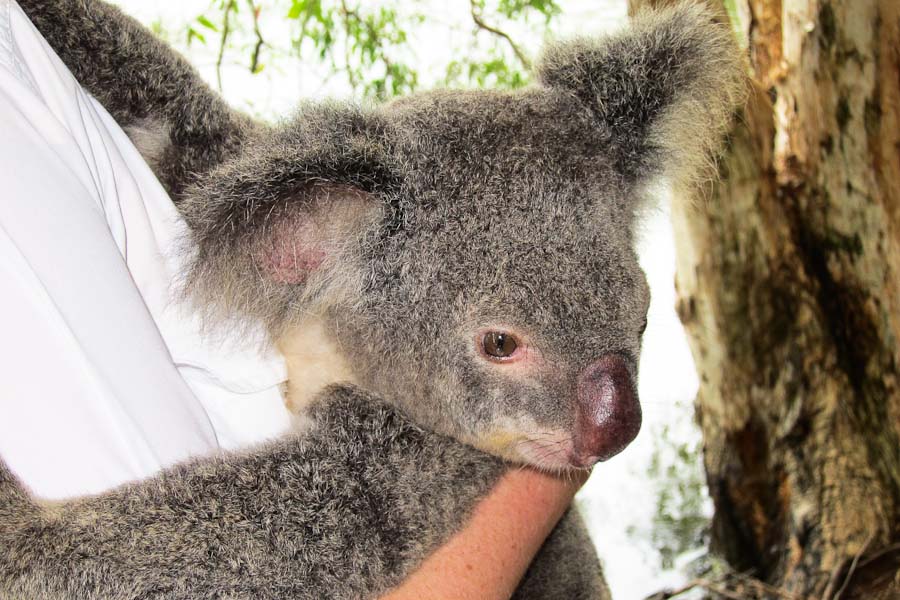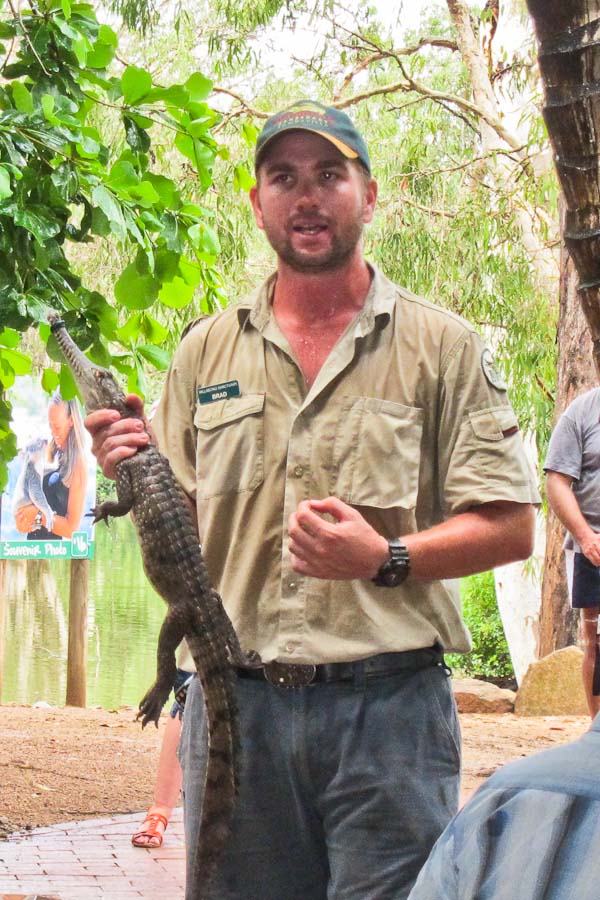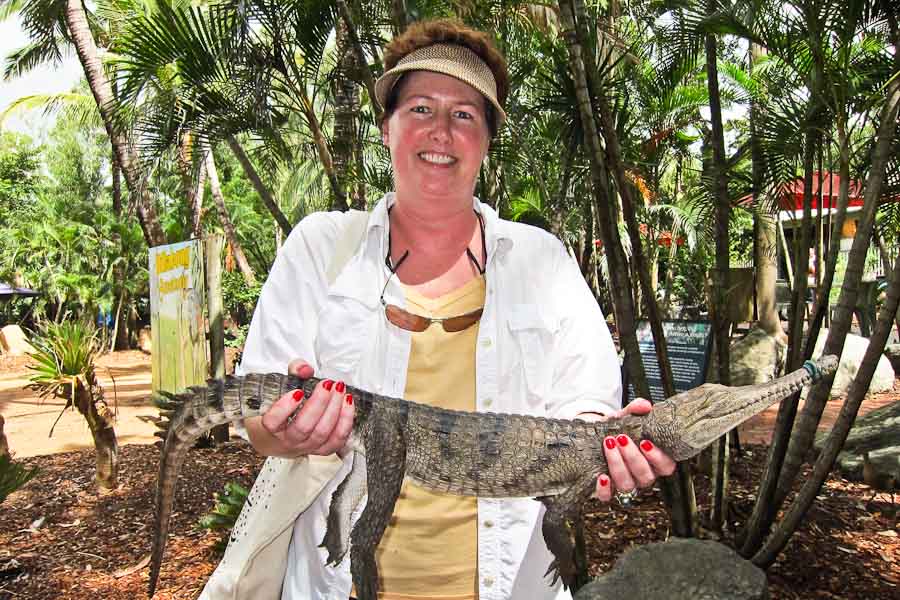Today we arrived at the port city of Townsville in the north-eastern Australian state of Queensland about 800 miles north of Brisbane. Honestly, we’ve never heard of Townsville before but we should have. Townsville is adjacent to the central section of the Great Barrier Reef which is about an hour’s fast boat ride offshore. There is also an interesting island called Magnetic Island that is about 5 miles away and a popular tourist attraction. It is called “magnetic” because Captain Cook thought forces from this island were throwing off his compass. Turns out it wasn’t the island that was the problem but the large amounts of uranium contained in Castle Hill, a large granite hill in the middle of Townsville.
Click here for the detailed Townsville Photo Gallery.
During WWII 50,000 U.S. and Australian troops were stationed here and they staged many bombing raids. Today, Townsville has one of the most successful and diverse economies in Australia and even has an international airport.
We were optimistic that the weather would hold today as we planned to go to the Billabong Sanctuary as part of a bus tour of Townsville. It continues to get warmer and more humid each day as we move closer towards the equator which we’ll reach at the end of this leg of the trip in Singapore.
We traveled about an hour on a bus to get to the Billabong Sanctuary and were immediately welcomed by an unexpected deluge. Well, actually, they always expect rain this time of the year in these parts as we enter the tropics. We dashed as best we could in the slippery mud to a covered area where we saw for the first time what a “Billabong” is.
We thought, when we first heard the term, that a Billabong was some sort of Australian bird or reptile or maybe even trendy sportswear (there is a brand of clothing with the same name). But as it turns out, a billabong is a section of still water adjacent to a river, cut off by a change in the water course, leaving the former branch with a dead end. But as we stood in front of one, it was really nothing more than a pond. In the arid Australian climate in which these “dead rivers” are found, they are dry for a significant part of the year, fill with water seasonally, support a great deal of wildlife and are very important in the Aboriginal culture.
The guides gave us some background information on the sanctuary and then brought out a python and a baby freshwater crocodile for us to hold! Soon after we found our way to the Koala area and got to hold a 5-year-old female. She was very nice and had a soft and fluffy coat.
The koalas had their own area in the park and we watched them for a while as it began to rain, starting softly and then turning into a downpour that lasted for 20 minutes. Because it was raining so hard, we were “trapped” standing in the koala area under a tin roof with 20 other people. As we were waiting, a kangaroo hopped over to us and stood under the roof with us like he was our dog. He was getting out of the rain as well! We were able to take some photos of him as he comfortably hung around next to us.
When the rain started to subside we walked around the park some more, found friendly black and white cockatiels and then made our way back to the large covered area where we had started our tour. There were some more folks from another Regent bus getting an overview and we stayed to watch. They ended up bringing in some more animals, including a wombat – which looked like a “ROUS” (Rodent of Unusual Size), but is actually a marsupial. The wombat was so docile, the handler cuddled it like a baby (like a big, rodent baby), it just lay there with a very peaceful look on its face.
Next, he brought in a dingo, which is a free roaming wild dog but seemed quite tame and more like a pet than a wild animal. It was obvious that the workers at this sanctuary spend a lot of time working with these animals. Dingos are different from domesticated dogs in that they breed only one time a year but have been inbred with domesticated dogs over the last few decades. They are considered to be pests by sheep farmers but helpful to the cattle ranchers as they are major predators to the damaging rabbits, kangaroos and rats.
When the rain started to die down again, I decided to take a walk around the remainder of the sanctuary. While it wasn’t raining that hard, the dirt paths had become so muddy it was hard to walk without slipping. I made my way and found some large salt-water crocodiles, smaller fresh water crocodiles and several wallabies – that are really just smallish kangaroos. By the time I got to the end of the sanctuary, I realized that the time had come to hurry back to the bus in the slippery mud and found the bus just in time. Of course, they wouldn’t have left me there in any case as they do a passenger count and Dale wouldn’t leave me stranded!
The driver took us on a drive around Townsville and gave us the typical bus tour TMI (Too Much Information) background and history on the area. He was very thorough and we learned more than we may have needed to know. We also took a drive up to Castle Hill, just a few feet short of being a mountain, to get a panoramic view of the area in a slight rain shower. The locals use the hill as a walking and running track and don’t really like the fact that these tour buses, which pay for special permits, interrupt their “private” exercise facility. We finally made it back to the Voyager and had dinner with our new friends, the Dooleys. Next we’re off to Cairns and The Great Barrier Reef.
Photography Comments:
Not much to say. It was raining much of the day which, of course, makes it difficult to keep your lens dry. So, photo hygiene is important. Keep checking to make sure you don’t have water drops, wet or dry on your lens throughout the day or your pictures will be fuzzy. Of course, when I talk to people on buses I seldom find people who EVER check to make sure their lens is clean. I’m sure there are plenty of people out there that do but I just never seem to find them. They are pretty happy when they find out that, just by cleaning their lens for them with my lens cleaning cloth, that their pictures improve dramatically. That’s nice! It is especially hard in an area like Northern Australia where, even when it’s not raining, it is terribly hot and humid which causes your lens to cloud up, sometimes leaving small water droplets. In a situation like this you just have to settle for documenting where you’ve been while you try not to slip in the mud. Also, the bus windows were very wet with large water drops…an almost impossible situation even if you get the camera right up against the glass.
Koalas are nice photo subjects since they move slowly. In fact, all the animals today were good subjects because, except for the birds, they all just stood there looking at you, barely moving at all. Even multiple flashes don’t bother koalas who seem to love having their picture taken. Margaret didn’t have a camera with her when she did her walk-a-bout with the crocs so there aren’t any shots of them.



.jpg)



Trip Summary » Travel with Dale & Margaret - […] Townsville, Australia […]